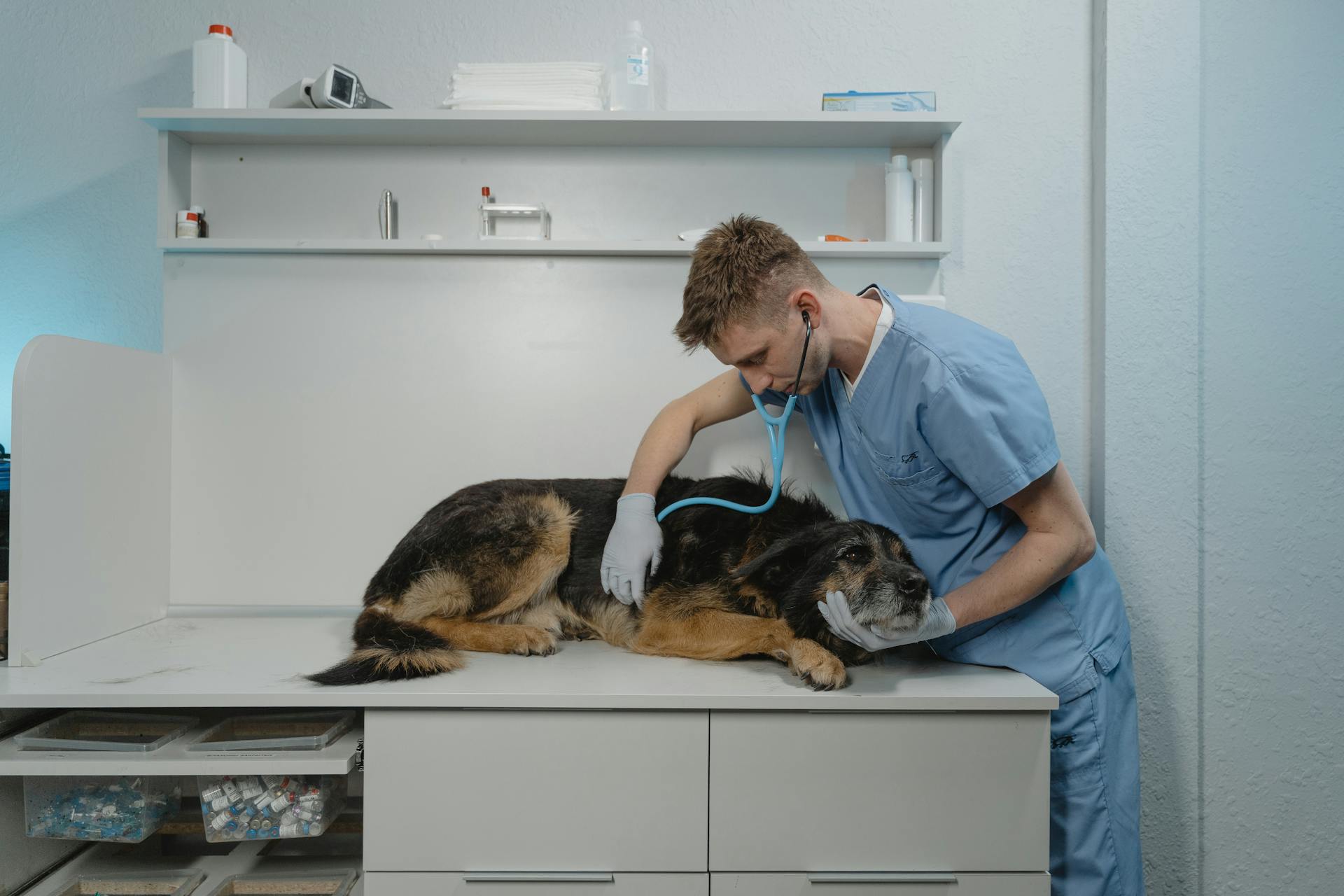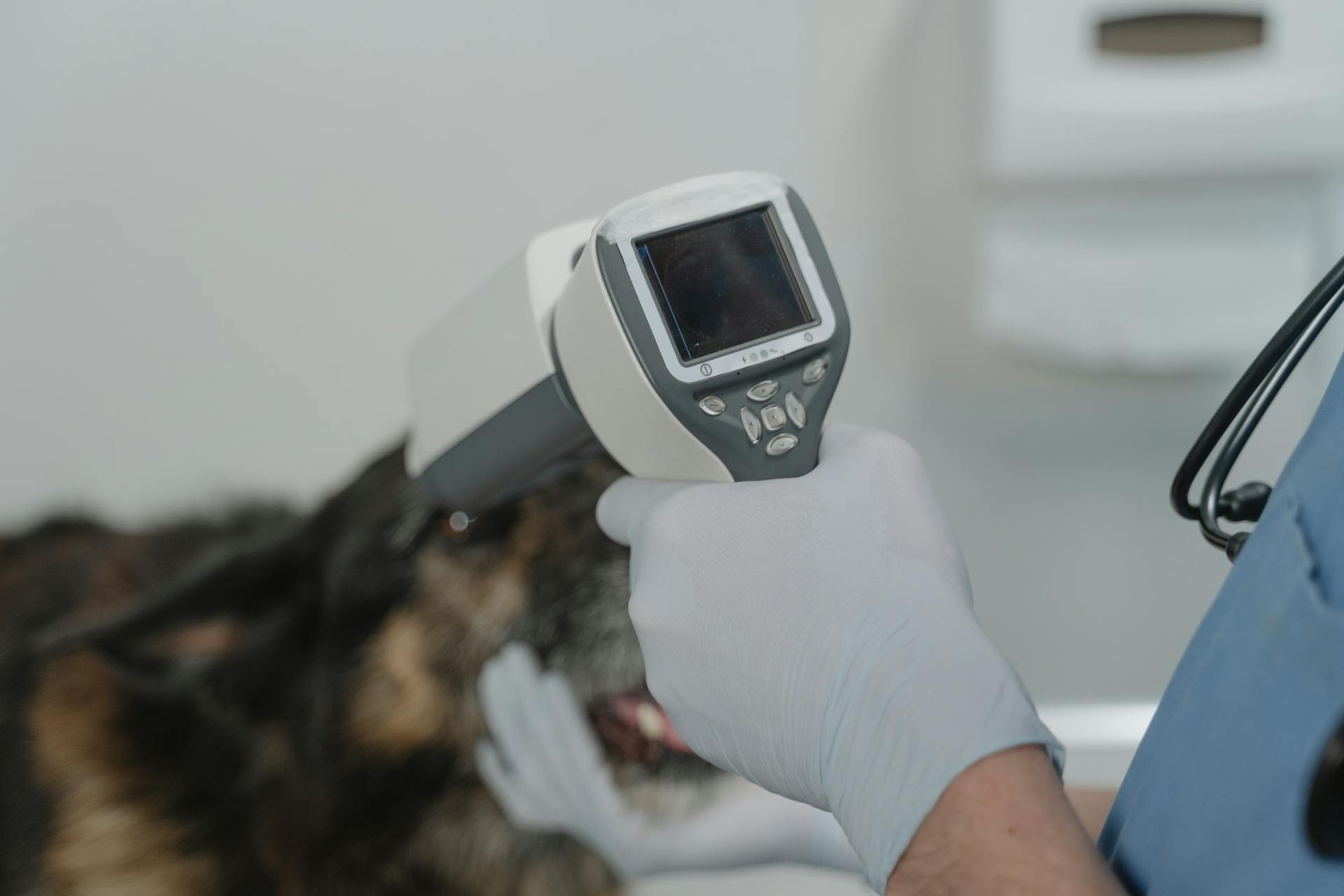
Canine lupus disease is a complex condition that affects dogs of all ages and breeds. There are several types of lupus that can affect dogs.
Systemic lupus erythematosus (SLE) is one of the most common forms of lupus in dogs. It's a chronic autoimmune disease that can affect multiple organs and systems in the body.
SLE in dogs is characterized by the presence of antinuclear antibodies (ANAs), which are a hallmark of the disease. These antibodies can attack healthy tissues and organs, leading to a range of symptoms.
The exact cause of SLE in dogs is still unknown, but it's believed to be triggered by a combination of genetic and environmental factors.
What is Canine Lupus Disease?
Canine lupus disease is a complex and multifaceted condition that affects dogs of all ages and breeds.
It's caused by a combination of genetic and environmental factors, including exposure to sunlight, certain medications, and hormonal imbalances.
Dogs with lupus often experience symptoms such as joint pain, fever, and skin lesions, which can be severe and debilitating.
Their immune system mistakenly attacks their own tissues, leading to inflammation and damage.
Some common symptoms of canine lupus include kidney disease, anemia, and neurological problems.
The disease can be challenging to diagnose, as its symptoms often mimic those of other conditions.
In some cases, dogs may experience a sudden onset of symptoms, while in others, the disease may progress slowly over time.
The prognosis for dogs with lupus varies depending on the severity of the disease and the effectiveness of treatment.
Symptoms and Signs
Crusts, scabs, erosions, or ulcers on the skin are common signs of discoid lupus erythematosus in dogs. These skin lesions often appear around the nose, and can be accompanied by a loss of skin pigmentation in the affected area.
Heavy bleeding can occur if skin lesions are located near a major blood vessel, which is why it's essential to monitor your dog's skin closely. Skin lesions can also spread to other areas of the body, such as the skin around the eyes, ear flaps, and genitals.
In some cases, skin lesions can become generalized, covering the entire body, although this is uncommon.
Causes of Discoid

Discoid lupus erythematosus in dogs is often linked to ultraviolet (UV) light, which can cause allergic reactions or make the condition worse, especially in sunny climates.
UV radiation is thought to set off inflammation, contributing to the condition.
Middle-aged dogs may be at higher risk of developing discoid lupus erythematosus.
Check this out: Canine Lupus Erythematosus
Signs & Symptoms
If your dog has discoid lupus erythematosus, you may notice crusts, scabs, erosions or ulcers on the skin, mostly originating around the nose. The hairless area surrounding the nostrils will also become smooth and lose its cobblestone-like texture.
Skin lesions can be quite painful and may bleed heavily if they're located near a major blood vessel. This is especially true for the skin surrounding the nose, which has a well-developed blood supply.
In some cases, skin lesions can spread to other areas of the body, such as the skin around the eyes, ear flaps, and genitals. Skin lesions can also become generalized, spreading across the entire body, although this is uncommon.
Here are some common symptoms of immune-mediated polyarthritis:
- High fever
- Joint pain or swelling
- Lameness that shifts from leg to leg
- Enlarged lymph nodes
In about half of the cases of immune-mediated polyarthritis, dogs go into remission after being treated with corticosteroids.
Cutaneous Vasculitis
Cutaneous Vasculitis is a type of inflammation that affects the blood vessels in the skin. This condition can cause a range of symptoms, including red, purple, or blue spots on the skin, which can be painful and itchy.
These spots can appear anywhere on the body, but are most commonly found on the legs, arms, and face. They can be small and scattered or large and clustered.
In some cases, Cutaneous Vasculitis can cause the skin to crack and bleed, leading to open sores that can become infected. This is a serious complication that requires prompt medical attention.
The exact cause of Cutaneous Vasculitis is often unknown, but it is thought to be related to an underlying medical condition, such as an infection, autoimmune disorder, or cancer.
If this caught your attention, see: Can Allergies Cause Swollen Lymph Nodes in Dogs
Diagnosing
Diagnosing canine lupus disease can be a challenging task due to its similarity in symptoms to other autoimmune diseases. Your veterinarian will likely recommend a combination of tests to determine if your dog has lupus.
A blood test is often the first step in diagnosing lupus in dogs. This test can check for liver or kidney damage, anemia, and low platelet count. It's also used to evaluate for excessive protein loss in the urine.
The ANA test is a crucial diagnostic tool for lupus in dogs. It identifies the presence of antibodies against self-components found in the cell nucleus and is positive in 90 percent of dogs with systemic lupus erythematosus.
In some cases, a biopsy may be necessary to confirm a diagnosis of lupus. This involves taking a small piece of skin from the affected area and examining it under a microscope for pathologic changes.
Here are the common diagnostic methods for lupus in dogs:
- Blood tests to check for liver or kidney damage, anemia, and low platelet count
- Urinalysis to evaluate for kidney damage
- ANA test to identify antibodies against self-components
- Biopsy to examine skin lesions under a microscope
A detailed history of your dog's medical care and how they respond to trial treatments can also be helpful in diagnosing lupus. Your veterinarian will want to know about any changes to your dog's eating habits or environment that may be contributing to their symptoms.
Treatment Options
Systemic lupus erythematosus (SLE) is a serious autoimmune disease that requires lifelong immunosuppressive treatment. This treatment typically includes a combination of high doses of glucocorticoids like prednisone and other immunosuppressive drugs like cyclophosphamide, azathioprine, and chlorambucil.
The initial dosage of prednisone is usually 1 milligram per pound of body weight given twice daily for 10 to 14 days, known as the induction period. After this period, the dosage is gradually tapered over several weeks until an every-other-day regimen is achieved.
Azathioprine, also known as Imuran, can be used in conjunction with prednisone at a dosage of 1 milligram per pound of body weight every day or every other day. However, it can cause bone marrow suppression, liver disease, and pancreatitis, and may take 6 to 8 weeks to achieve its full effect.
Chlorambucil, also known as Leukeran, can be used in conjunction with glucocorticoids at a dosage of 0.1 milligram per pound of body weight every other day. It may be safer than azathioprine but still has the potential for bone marrow suppression.
Readers also liked: Incubation Period of Kennel Cough for Dogs
In some cases, gold salts may be used to treat immune-mediated disease in dogs, but they should be avoided in dogs with kidney disease due to their potential for causing kidney damage and protein loss in the urine.
Here is a summary of the common immunosuppressive drugs used to treat SLE in dogs:
Discoid lupus erythematosus, on the other hand, is a cosmetic condition that cannot be cured, but treatment can help manage symptoms. Treatment may include antibiotics like Cephalexin, vitamin E, omega 3 fatty acids, and topical steroids like Tacrolimus.
Readers also liked: Canine Lick Granuloma Treatment
Home Care and Prevention
Dogs with lupus need to be monitored carefully for adverse effects, which may include gastrointestinal ulceration resulting in vomiting, diarrhea, dark tarry stools, loss of appetite, increased water consumption, increased urinations, and increased appetite.
Frequent blood evaluations are crucial to ensure that cell counts don't decrease too much, as these drugs have the potential to cause bone marrow suppression.
Your dog may also need antibiotics to combat secondary bacterial infections.
Setting up a comfortable space for your dog is essential, as comfort is important for a dog dealing with lupus.
Make necessary changes in your dog's diet and add exercise and daily activities to its routine to help with recovery.
Prognosis and Recovery
The prognosis for dogs with systemic lupus erythematosus is guarded and depends on the extent of kidney damage and the severity of anemia and thrombocytopenia.
Unfortunately, as many as 40 percent of dogs with systemic lupus erythematosus die within one year after diagnosis due to the disease itself or adverse effects of treatment.
Recovery from discoid lupus erythematosus in dogs can be a long-term process, requiring lifelong treatment and management.
Symptoms of discoid lupus erythematosus may disappear within a few days to months with treatment prescribed by a veterinary dermatologist.
Your dog's quality of life and symptoms subsiding will determine the success of their recovery.
Readers also liked: Canine Discoid Lupus Treatment
In some cases, with proper treatment, your dog's symptoms may disappear completely.
Here's a summary of the prognosis and recovery timeline for dogs with systemic lupus erythematosus:
- 40% of dogs with systemic lupus erythematosus die within one year after diagnosis.
- Recovery from discoid lupus erythematosus may take a few days to months with proper treatment.
Autoimmune Diseases
Autoimmune diseases in dogs, such as Systemic Lupus Erythematosus (SLE), can be challenging to manage. Certain breeds like Afghan Hounds, Beagles, Collies, German Shepherds, Irish Setters, Old English Sheepdogs, Poodles, and Shetland Sheepdogs are more predisposed to the condition.
Typically, symptoms of SLE appear around age six, but can show up at any age, and often flare up or go into remission for periods of time. The disease can affect multiple organs, including the skin, heart, lungs, kidneys, joints, blood, and nervous system.
Some common symptoms of SLE include lameness or pain in one or more joints and muscles, increased drinking or urination, ulcers on the face or feet, lesions, scars, ulceration, or crusting on the skin, alopecia (hair loss), loss of pigment in the nose, fever, anemia, thyroid problems, swollen lymph nodes, kidney infections, and spleen, liver, or kidney enlargement.
Additional reading: Canine Kidney Anatomy
In addition to SLE, other autoimmune diseases in dogs include autoimmune hemolytic anemia (AIHA), which occurs when the dog's immune system attacks the body's red blood cells, and autoimmune skin diseases, such as pemphigus, discoid lupus erythematosis, and Vogt-Koyanagi-Harada-like syndrome.
Here are some common symptoms of AIHA:
- Weakness or lethargy
- Weight loss or anorexia
- Increased heart rate and breathing
- Pale mucous membranes on the gums and eyes
- Fever
- Jaundice
- Discoloration of the eyes, gums, and skin
- Collapse, in severe cases
Treatment for autoimmune diseases in dogs typically involves the use of corticosteroids, immunosuppressive drugs, and in some cases, surgery.
Types of Diseases
Autoimmune diseases of the skin in dogs can be a challenge to diagnose and treat. Pemphigus, for example, can cause scaly skin, scabs, or pus-filled sores, and even blisters that rupture quickly.
There are several types of autoimmune skin diseases in dogs, each with its own unique symptoms. Here are a few examples:
- Pemphigus: scaly skin, scabs, or pus-filled sores, and blisters that rupture quickly
- Discoid lupus erythematosis: loss of pigment, scaly skin, or scabby sores around the nose
- Vogt-Koyanagi-Harada-like syndrome: loss of pigmentation and eye disease
Some autoimmune skin diseases can be more severe than others. Pemphigus vulgaris, for instance, can cause ulcers to appear at the mouth, anus, prepuce, nose, and vagina.
Autoimmune Diseases
Autoimmune diseases in dogs are a complex and often misunderstood group of conditions. Some breeds, such as Afghan Hounds, Beagles, and Poodles, are more predisposed to certain autoimmune diseases.
Readers also liked: Autoimmune Disease in German Shepherds
Autoimmune diseases can affect multiple organs and systems in a dog's body, including the skin, heart, lungs, kidneys, joints, blood, and nervous system. Symptoms can include lameness or pain in one or more joints and muscles, increased drinking or urination, and ulcers on the face or feet.
Dogs with autoimmune diseases may also experience hair loss, loss of pigment in the nose, fever, anemia, and thyroid problems. In severe cases, hospitalization may be necessary until the condition can be managed.
There are several types of autoimmune diseases in dogs, including Systemic Lupus Erythematosus (SLE), Autoimmune Hemolytic Anemia (AIHA), and various skin diseases. Some of these conditions can be managed with medication, while others may require more aggressive treatment.
Here are some common symptoms of autoimmune diseases in dogs:
- Lameness or pain in one or more joints and muscles
- Increased drinking or urination
- Ulcers on the face or feet
- Hair loss
- Loss of pigment in the nose
- Fever
- Anemia
- Thyroid problems
- Swollen lymph nodes
- Kidney infections
- Spleen, liver, or kidney enlargement
While the causes of autoimmune diseases in dogs are unknown, there is a hereditary component for some breeds, and exposure to ultraviolet light can make the condition worse. With proper care and treatment, many dogs with autoimmune diseases can lead happy and healthy lives.
A fresh viewpoint: Dog Autoimmune Diseases
Frequently Asked Questions
How long will a dog live with lupus?
Dogs with lupus will live with the condition for their entire lifetime. Treatment can help manage symptoms, but a cure is not currently available.
What triggers lupus flare-ups in dogs?
Lupus flare-ups in dogs can be triggered by environmental factors like UV light and cigarette smoke, as well as stress and certain dog breeds. Knowing the common triggers can help you better manage your dog's condition and prevent future flare-ups.
What happens if you don't treat lupus in dogs?
If left untreated, lupus in dogs can lead to serious complications, including an increased risk of developing skin cancer like squamous cell carcinoma. Untreated lupus can also cause long-term damage to a dog's skin, organs, and overall health.
Sources
- https://www.petplace.com/article/dogs/pet-health/systemic-lupus-erythematous-sle-in-dogs
- https://vetfocus.royalcanin.com/en/scientific/canine-cutaneous-autoimmune-disease
- https://dogtime.com/dog-health/52995-autoimmune-disease-dogs-types-symptoms-treatments
- https://www.fitbark.com/blog/lupus-in-dogs
- https://www.animalfriendsdermatology.com/site/blog/2024/04/30/discoid-lupus-erythematosus-dogs
Featured Images: pexels.com


